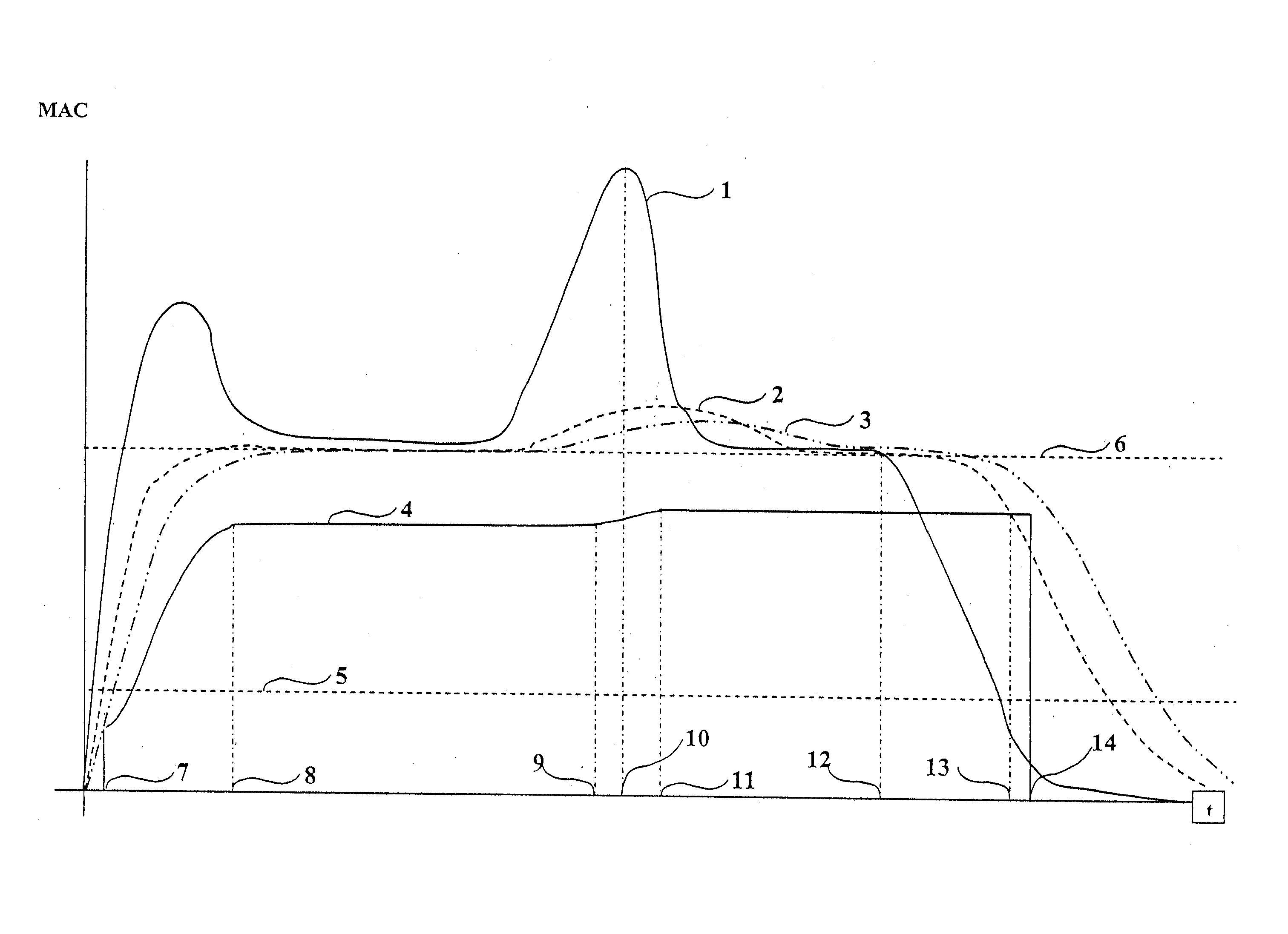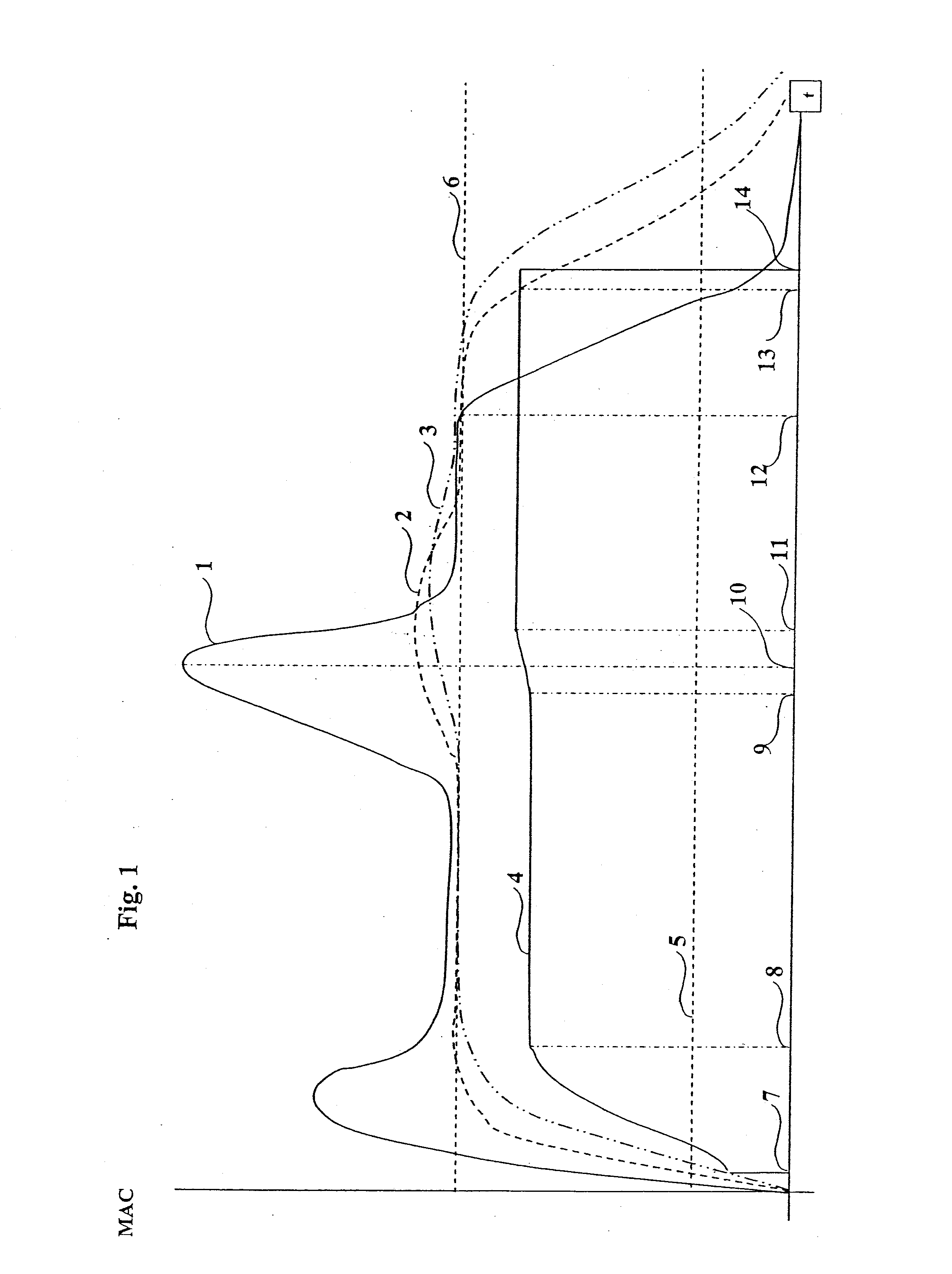[0010]The object of the present invention is therefore to create a monitoring device for monitoring the therapy and especially anesthesia as well as a therapy device equipped therewith and especially an
anesthesia device with automatic activation of an alarm means to avoid or reduce at least false positive alarms while ensuring at the same time the greatest possible safety for the patient. The object of the present invention is, moreover, to provide a corresponding process for triggering an alarm as well as a process for the treatment and especially the anesthesia of a patient.
[0020]The present invention is advantageously characterized in that, on the one hand, the alarm means for triggering an alarm is automatically activated only when, for example, a first phase of an anesthesia, during which most of the false alarms, especially false positive alarms, are triggered due to the slow build-up of the gaseous anesthetics or the gaseous
anesthetic, has concluded and certain MAC concentrations have been reached in the inspiration or expiration gas. The appearance of false alarms as well as alarms that are triggered because certain gas concentrations could not reach or exceed a lower warning limit is advantageously prevented hereby. Consequently, the physician is also not diverted from work because no alarms have been triggered at all. For the same reason, the physician has, moreover, no motivation for deactivating the alarm means, and consequently, the physician also cannot forget to restart the alarm function or to reactivate the alarm function, which would be necessary after deactivation. The safety of the patient being anesthetized is markedly improved when the monitoring device according to the present invention is used.
[0023]It is thus advantageously ensured that the physician is relieved of the task of setting the lower warning limit in such a way that it is adapted to the particular case or of having to set it on the device side. This setting is performed automatically according to criteria set in advance, as soon as the three MAC values have risen to a level above a
lower threshold value and it is thus ensured that a desired
depth of anesthesia or phase of anesthesia is reached. In addition, one cannot forget to set the lower warning limit if it had not been set already. This is carried out rather automatically in this embodiment, and at a time at which the setting is not a reason for false alarms. It is noted that the action according to the present invention and the advantages associated herewith are also achieved if only the exceeding of the
lower threshold value by any two MAC values is taken into account to set the lower warning limit instead of the exceeding of the
lower threshold value by the three MAC values mentioned as examples here.
[0024]As is provided in another preferred embodiment according to the present invention, the monitoring device may have for this purpose a means for automatically setting the lower warning limit, by means of which the lower warning limit can be set at a predeterminable percentage of one of the MAC values determined to set the warning limit, for example, of the lowest of these MAC values. The percentage may be related here to a MAC value of the lowest MAC value which is averaged or filtered in another manner. It may also be related to the MAC value at the level measured last. This is left up to the person skilled in the art. An essential
advantage of this embodiment is that the warning limit is set automatically and individually for the patient and the
respiration parameters or MAC values thereof. Such a percentage may be, for example, above 50% of the lowest of the MAC values determined, preferably above 60%, especially preferably between 65% and 75% and especially preferably at 70%. Provisions may be made, especially in this embodiment of the present invention, for automatically adjusting the warning limit to, e.g., always 70% of the lowest MAC value in a simple manner, and a resetting of the warning limit to always higher values than before—but not to lower values than before—is preferred. On the one hand, this percentage guarantees the safety of the anesthesia for the patient, and, on the other hand, the distance between the warning limit and the determined MAC values is sufficiently great to avoid false alarms.
[0025]Yet another, likewise preferred embodiment according to the present invention is characterized in that it has a means for setting a maximum value for the lower warning limit. An
advantage of this embodiment according to the present invention is that there is no premature alarm in case of declining MAC values because of a lower warning limit set automatically or independently unrealistically high. The lower warning limit could be set at such an undesirably high value, for example, due to instantaneous freak values of the MAC value(s) being considered in the upward direction, which are, however, not typical for this value in the
time curve of the MAC values. This also applies to an instantaneous, especially initial rise in the concentration of a gaseous
anesthetic intended by the physician for the purpose of more rapid build-up. The above-described average, which is proposed as a possibility, or
filtration according to another method, is not absolutely necessary by means of this embodiment according to the present invention when setting the percentage. This advantageously leads to a simplification of the design of the monitoring device according to the present invention.
[0027]The alarm means of the monitoring device of another preferred embodiment is suitable and set up to trigger an alarm whose intensity increases over time. The alarm therefore begins quietly and initially disturbs the persons present in their work less than at a later point in time. Thus, the persons present do not fail to see and / or hear an alarm, on the one hand, and, on the other hand, it is not necessary to interrupt any activity immediately upon the onset of the alarm in order to end the alarm immediately. This is pleasant and above all advantageous above all when the physician or the attending therapist must walk only a few steps to the patient or the
anesthesia device and an alarm that is already very intense initially would otherwise needlessly burden the persons present until they reach the anesthesia device. An alarm that is more intense from the very beginning would not “alarm” the person in charge “more” but would only be more unpleasant for all persons concerned. In addition, in case of a gradually increasing intensity, a physician, who is still performing other tasks in the meantime, can also assess the urgency of the alarm and whether he can still conclude the work just being performed before he addresses those circumstances triggering the alarm. The time elapsing until the alarm is increased (i.e., until its intensity increases) can be selected to be such that the alarm is intensified at the latest after the end of a time that corresponds to 50% of the
time constant of the fastest gas present in the gas mixture (i.e., the gas with the shortest
time constant). This consequently generates an alarm in time before the unintended waking up of the patient.
 Login to View More
Login to View More  Login to View More
Login to View More 

